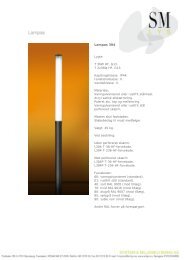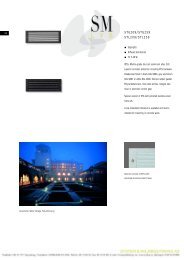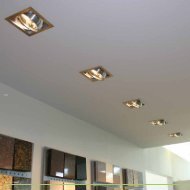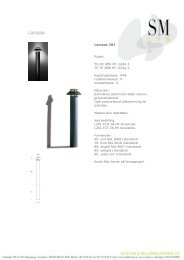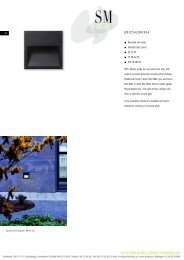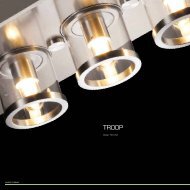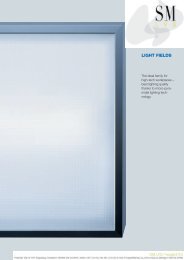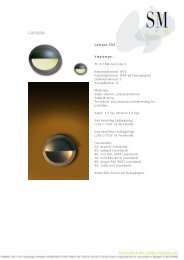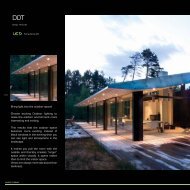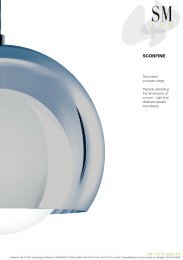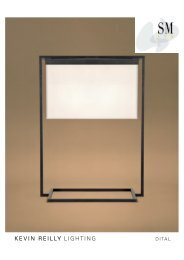Create successful ePaper yourself
Turn your PDF publications into a flip-book with our unique Google optimized e-Paper software.
CLT: CONSTANT LUMINANCE TECHNOLOGY<br />
METHODS OF DIMMING<br />
> CONSTANT LUMINANCE TECHNOLOGY<br />
> INTEGRAL ELECTRONIC SENSORS MAINTAIN CONSTANT LUMINANCE THROUGHOUT THE ENTIRE LIFE<br />
OF LAMP AND LUMINAIRE<br />
> UP TO 25% SAVINGS IN ENERGY<br />
> RECOMMENDED LUMINANCES ARE NEVER EXCEEDED<br />
> CONSTANT LUMINANCE TECHNOLOGY GUARANTEES CONSTANT LUMINANCE UNDER 1000CD/M 2<br />
(FOR GAMMA>65°, ALL-ROUND RADIATION) THROUGHOUT THE ENTIRE LAMP LIFE<br />
> THANKS TO CONSTANT LUMINANCE THE MAINTENANCE FACTOR FOR LAMP AND LUMINAIRE CAN BE<br />
RATED 1<br />
> THE PATENT-PENDING CLT REDUCES INITIAL LUMINOUS FLUX TO APPROX. 70% AND COMPENSATES<br />
NORMAL LIGHT LOSS UP TO LAMP REPLACEMENT<br />
> THE LUMINANCE REMAINS THE SAME AFTER REPLACEMENT OF LAMPS<br />
> THE DIMMING METHOD HAS TO BE SPECIFIED BEFORE ORDERING. A SWITCHING OF THE ELECTRONIC<br />
BALLAST FOR ANOTHER METHOD IS NOT POSSIBLE.<br />
> WHEN ORDERED, THIS CONTROL WIRE FOR A SPECIAL DIMMING METHOD IS PART OF THE THROUGH<br />
WIRING.<br />
> THE DIMMING OF FLUORESCENT LAMPS WITH ELECTRONIC BALLASTS IS MANAGED BY A CONTROL WIRE.<br />
> BUILDING MANAGEMENT SYSTEMS SUCH AS EIB, LCN, LON AND DMX GENERALLY REQUIRE SPECIAL<br />
INTERFACES BETWEEN CONTROLS AND LUMINAIRES.<br />
THE FOLLOWING METHODS OF DIMMING ARE POSSIBLE AS STANDARD:<br />
Luminance without CLT<br />
…/04 CONTROL VIA 1–10V INTERFACE<br />
1000cd / m 2<br />
Replacement of lamps<br />
Luminance with CLT<br />
Dimming 1%–100% by analogue command. Current consumption<br />
is about 0.6mA per electronic ballast. Switching off by an external<br />
relay. 2 additional wires are needed besides mains feed. The control<br />
wire is separated from the mains feed, but there is no Safety Extra<br />
Low Voltage (SELV) protection.<br />
Installation allowed for cables and connections for 230V / 240 V<br />
only. Common core wires are allowed for mains and control cables.<br />
The control wires have to be connected with the right polarity +/- .<br />
Wrong polarity causes malfunction.<br />
0 2 4 6<br />
Years of use<br />
… /05 CONTROL VIA DIGITAL SIGNAL INTERFACE (DSI)<br />
Energy consumption without CLT<br />
Energy consumption with CLT<br />
Energy saving potential by<br />
the use of CLT<br />
PATENT PENDING<br />
Dimming 1%–100%, switching off by a digital command. Digital<br />
switch-off consumes standby wattage of >0.8W. Two additional<br />
wires are needed besides mains feed. The control wire is separated<br />
from the mains feed, but there is no Safety Extra Low Voltage (SELV)<br />
protection.<br />
Installation allowed for cables and connections for 230V / 240 V<br />
only. Common core wires are allowed for mains and control cables.<br />
The control wires are independent of the polarity. Wrong polarity<br />
does not cause malfunction.<br />
TECHNICAL APPENDIX<br />
Innovative CLT (Constant Luminance Technology) uses an integrated<br />
sensor inside the luminaire. CLT makes sure that the luminaire<br />
always performs to the same level – irrespective of the age of the<br />
light source or the soiling of the luminaire.<br />
To ensure this level, a photometric sensor measures the light<br />
radiated by the lamp. As the lamp ages and the luminaire becomes<br />
soiled, the luminous flux radiated by the lamp and luminaire / the<br />
luminance of the luminaire surfaces decreases. A sensor detects<br />
this decrease and triggers the dimmable electronic ballast via a<br />
servo loop until the initial luminous flux values and the luminance<br />
values of the luminaire surfaces have been regained. The ageing<br />
process is thus compensated by adjustment through the ballast.<br />
The luminance of the adjusted luminaire can be set at a value<br />
substantially below the new value of a conventional lighting<br />
installation.<br />
This innovation guarantees constant luminous flux/constant<br />
luminance of every luminaire throughout its entire service life.<br />
The lighting designer does not need to take lamp and luminaire<br />
maintenance factors into consideration during the planning<br />
phase, i.e. the lighting installation does not need to be oversized<br />
to compensate for potential light loss. A luminaire equipped with<br />
CLT can be dimmed using Switch Dim. The luminaire can be set at<br />
luminances above or below the default CLT value.<br />
This means, for example, that the maximum permissible values<br />
for workspaces with computer monitors are never exceeded and /<br />
or the planned illuminances in the space are always adhered to.<br />
Thanks to this process, illuminances calculated up to 50 per cent<br />
higher for new lighting installations (together with the increased<br />
energy consumption this entails) are as much a thing of the past as<br />
falling below the minimum value recorded for installations that are<br />
seldom cleaned. CLT supports reductions in energy use of between<br />
eight and 25 per cent (depending on the maintenance schedule of<br />
the respective installation). CLT is only activated when the lighting<br />
installation is switched on. Standby operation, and the added<br />
energy consumption this implies, thus no longer applies.<br />
Luminaires equipped with CLT always provide the exact same<br />
amount of light. So the user always gets exactly the kind of electric<br />
light he expects – or that he has selected via the dimmer (switch/<br />
dim button). The user can define what kind of light is required and<br />
therefore have a hand in the design of the space.<br />
CLT technology makes for an ergonomically convincing alternative<br />
to simple systems that claim to provide constant lighting levels.<br />
In the case of lamp replacement in larger configurations of luminaires<br />
the uniform luminance of the overall installation remains<br />
the same to the eye.<br />
… /06 CONTROL VIA DIGITAL ADDRESSABLE LIGHTING INTERFACE (DALI)<br />
Addressing, grouping, dimming 1%–100%, switching off by a<br />
digital command. Digital switch-off consumes standby wattage of<br />
>0.5W. Two additional wires are needed besides mains feed.<br />
The control wire is separated from the mains feed, but there is no<br />
Safety Extra Low Voltage (SELV) protection. Installation allowed<br />
230<br />
INTERIOR<br />
… /07 CONTROL VIA SWITCH DIM<br />
Mains feed from pushbutton goes to a special contact of the<br />
electronic ballast. Dimming 1%–100% and switching on/off<br />
by a pushbutton command. Digital switch-off consumes standby<br />
wattage of >0.8W.<br />
… /08 CONTROL VIA CLT<br />
See page 230<br />
for cables and connections for 230V / 240 V only. Common core<br />
wires are allowed for mains and control cables. The control wires<br />
are independent of the polarity. Wrong polarity does not cause<br />
malfunction.<br />
One additional wire is needed besides mains feed. The control<br />
wire is part of mains feed. Installation allowed for cables and<br />
connections up to for 230V / 240 V only. Common core wires are<br />
allowed for mains and control cables.<br />
TECHNICAL APPENDIX<br />
231<br />
INTERIOR




